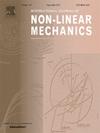3D finite element analysis of micromorphic hyperelastic structures considering finite deformations: Two-point formulation
IF 2.8
3区 工程技术
Q2 MECHANICS
International Journal of Non-Linear Mechanics
Pub Date : 2025-02-19
DOI:10.1016/j.ijnonlinmec.2025.105054
引用次数: 0
Abstract
The purpose of this article is to introduce a novel finite element (FE) approach for investigating the large deformations of three-dimensional (3D) micromorphic hyperelastic continua that have an arbitrary geometry. The 3D micromorphic hyperelasticity formulation is initially presented in a general form. To facilitate the procedure of coding, the vector-matrix counterparts of the aforementioned relations are also provided, which can be conveniently employed in numerical methods. Afterwards, an FE approach is implemented to investigate the large deformations of micromorphic hyperelastic structures under static loading. This is achieved via the user element (UEL) subroutine utilized by the commercial ABAQUS software. Problems with complex domains can be solved using this FE approach. Solving some test problems, including bending of a beam, Cook's membrane under bending load, a cracked spherical shell under external pressure point load and a cracked cylindrical shell under stretching load, demonstrates the fast convergence rate, simple implementation, accuracy and efficiency of the method. In addition, the influences of internal length and scale-transition parameters and geometrical properties on the finite deformation of considered micromorphic hyperelastic structures are evaluated.
考虑有限变形的微形态超弹性结构的三维有限元分析:两点公式
本文的目的是介绍一种新的有限元(FE)方法来研究具有任意几何形状的三维微形态超弹性连续体的大变形。三维微形态超弹性公式最初以一般形式提出。为了便于编码,文中还提供了上述关系的向量-矩阵对应物,便于在数值方法中使用。然后,采用有限元方法研究了静载荷作用下微晶超弹性结构的大变形。这是通过商业ABAQUS软件使用的用户元素(UEL)子例程实现的。这种方法可以解决复杂域的问题。通过对梁的弯曲、弯曲载荷作用下的库克膜、外压点载荷作用下的开裂球壳和拉伸载荷作用下的开裂圆柱壳等试验问题的求解,证明了该方法收敛速度快、实现简单、准确高效。此外,还评估了内部长度和尺度过渡参数以及几何性质对所考虑的微形态超弹性结构有限变形的影响。
本文章由计算机程序翻译,如有差异,请以英文原文为准。
求助全文
约1分钟内获得全文
求助全文
来源期刊
CiteScore
5.50
自引率
9.40%
发文量
192
审稿时长
67 days
期刊介绍:
The International Journal of Non-Linear Mechanics provides a specific medium for dissemination of high-quality research results in the various areas of theoretical, applied, and experimental mechanics of solids, fluids, structures, and systems where the phenomena are inherently non-linear.
The journal brings together original results in non-linear problems in elasticity, plasticity, dynamics, vibrations, wave-propagation, rheology, fluid-structure interaction systems, stability, biomechanics, micro- and nano-structures, materials, metamaterials, and in other diverse areas.
Papers may be analytical, computational or experimental in nature. Treatments of non-linear differential equations wherein solutions and properties of solutions are emphasized but physical aspects are not adequately relevant, will not be considered for possible publication. Both deterministic and stochastic approaches are fostered. Contributions pertaining to both established and emerging fields are encouraged.

 求助内容:
求助内容: 应助结果提醒方式:
应助结果提醒方式:


